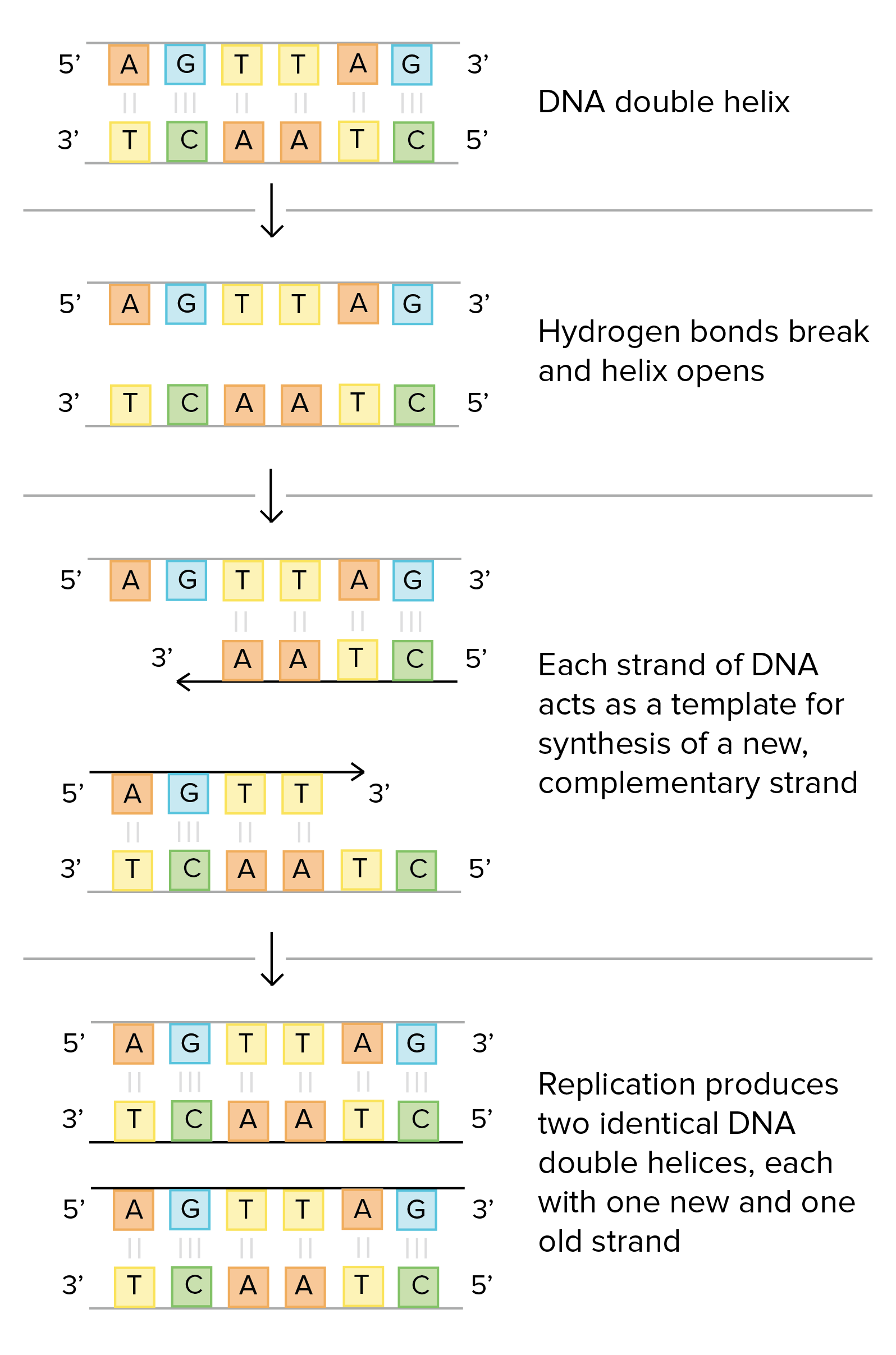What Acts As The Template In Dna Replication
What acts as the template in dna replication - We can conclude that dna replication is a semiconservative method in which each of the two parental dna strands acts as the template for new dna to be synthesised. Instead, the rna polymerase acts as a stable linker between the dna template and the newly forming rna strand to ensure that elongation is not. The base pairing between dna and rna is not stable enough to maintain the stability of the mrna synthesis components. After the completion of the dna replication, each dna has one parental (or old) strand and one daughter (or new) strand. A short segment of rna, called a primer, is then synthesized and acts as a starting point for. Others involve insertion or deletion of one or a few nucleotides. The dna is rewound behind the core enzyme as the hydrogen bonds are reformed. Dna replication initiates at specific points, called origins, where the dna double helix is unwound. A mutation (section 14.1) is a change in the nucleotide sequence of a short region of a genome (figure 14.1a).many mutations are point mutations that replace one nucleotide with another; Mutations result either from errors in dna replication or from the damaging effects of mutagens, such as chemicals and.
DNA & RNA Summary
A mutation (section 14.1) is a change in the nucleotide sequence of a short region of a genome (figure 14.1a).many mutations are point mutations that replace one nucleotide with another; Others involve insertion or deletion of one or a few nucleotides. A short segment of rna, called a primer, is then synthesized and acts as a starting point for.
DNA Replication Can Humans liver forever
The dna is rewound behind the core enzyme as the hydrogen bonds are reformed. Instead, the rna polymerase acts as a stable linker between the dna template and the newly forming rna strand to ensure that elongation is not. After the completion of the dna replication, each dna has one parental (or old) strand and one daughter (or new) strand.
Semi Conservative Theory Of Dna Replication SHOTWERK
Mutations result either from errors in dna replication or from the damaging effects of mutagens, such as chemicals and. A short segment of rna, called a primer, is then synthesized and acts as a starting point for. Instead, the rna polymerase acts as a stable linker between the dna template and the newly forming rna strand to ensure that elongation is not.
Adenoassociated virus (AAV) replication cycle and formation of dimeric
Others involve insertion or deletion of one or a few nucleotides. Instead, the rna polymerase acts as a stable linker between the dna template and the newly forming rna strand to ensure that elongation is not. A mutation (section 14.1) is a change in the nucleotide sequence of a short region of a genome (figure 14.1a).many mutations are point mutations that replace one nucleotide with another;
Genes Free FullText PrimPol—Prime Time to Reprime HTML
Others involve insertion or deletion of one or a few nucleotides. A mutation (section 14.1) is a change in the nucleotide sequence of a short region of a genome (figure 14.1a).many mutations are point mutations that replace one nucleotide with another; Dna replication initiates at specific points, called origins, where the dna double helix is unwound.
Why Nature Preferred DNA over RNA? Science Samhita
A short segment of rna, called a primer, is then synthesized and acts as a starting point for. Others involve insertion or deletion of one or a few nucleotides. Dna replication initiates at specific points, called origins, where the dna double helix is unwound.
Difference Between Replication and Transcription Compare the
We can conclude that dna replication is a semiconservative method in which each of the two parental dna strands acts as the template for new dna to be synthesised. Mutations result either from errors in dna replication or from the damaging effects of mutagens, such as chemicals and. The dna is rewound behind the core enzyme as the hydrogen bonds are reformed.
DNA Polymerase Structure, Functions in Pro and Eukaryotes
A short segment of rna, called a primer, is then synthesized and acts as a starting point for. A mutation (section 14.1) is a change in the nucleotide sequence of a short region of a genome (figure 14.1a).many mutations are point mutations that replace one nucleotide with another; Dna replication initiates at specific points, called origins, where the dna double helix is unwound.
Instead, the rna polymerase acts as a stable linker between the dna template and the newly forming rna strand to ensure that elongation is not. The dna is rewound behind the core enzyme as the hydrogen bonds are reformed. The base pairing between dna and rna is not stable enough to maintain the stability of the mrna synthesis components. Mutations result either from errors in dna replication or from the damaging effects of mutagens, such as chemicals and. Dna replication initiates at specific points, called origins, where the dna double helix is unwound. After the completion of the dna replication, each dna has one parental (or old) strand and one daughter (or new) strand. A mutation (section 14.1) is a change in the nucleotide sequence of a short region of a genome (figure 14.1a).many mutations are point mutations that replace one nucleotide with another; We can conclude that dna replication is a semiconservative method in which each of the two parental dna strands acts as the template for new dna to be synthesised. Others involve insertion or deletion of one or a few nucleotides. A short segment of rna, called a primer, is then synthesized and acts as a starting point for.






